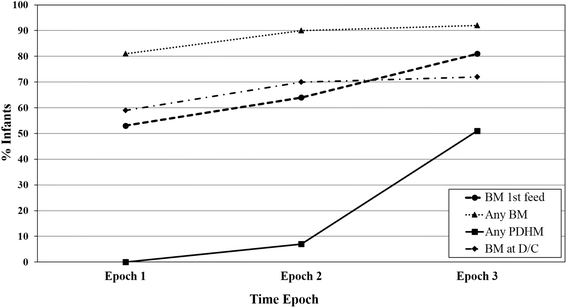Impact of umbilical cord milking and pasteurized donor human milk on necrotizing enterocolitis: a retrospective review
- PMID: 29739367
- PMCID: PMC5941565
- DOI: 10.1186/s12887-018-1131-x
Impact of umbilical cord milking and pasteurized donor human milk on necrotizing enterocolitis: a retrospective review
Abstract
Background: Necrotizing enterocolitis (NEC) is a serious complication of prematurity. Our objective was to evaluate the impact of an umbilical cord milking protocol (UCM) and pasteurized donor human milk (PDHM) on NEC rates in infants less than 30 weeks gestational age from January 1, 2010 to September 30, 2016. We hypothesized an incremental decrease in NEC after each intervention.
Methods: We performed a retrospective review of 638 infants born less than 30 weeks gestational age. Infants were grouped into three epochs: pre-UCM/pre-PDHM (Epoch 1, n = 159), post-UCM/pre-PDHM (Epoch 2, n = 133), and post-UCM/post-PDHM (Epoch 3, n = 252). The incidence of NEC, surgical NEC, and NEC/death were compared. Logistic regression was used to determine independent significance of time epoch, gestational age, birth weight, and patent ductus arteriosus for NEC, surgical NEC, and death/NEC.
Results: At birth, infants in Epoch 1 were younger than Epoch 2 and 3 (26.8 weeks versus 27.3 and 27.2, respectively, P = 0.036) and smaller (910 g versus 1012 and 983, respectively, P = 0.012). Across epochs, there was a significant correlation between patent ductus arteriosus treatment and NEC rate (P < 0.001, Cochran-Mantel-Haenszel). There was a significant decrease in rates of NEC, surgical NEC, and NEC/death between groups. Logistic regression showed this as significant for rates of NEC and surgical NEC between Epoch 1 and 3. Patent ductus arteriosus was a significant variable affecting the incidence of NEC, but not surgical NEC or death/NEC.
Conclusions: An umbilical cord milking protocol and pasteurized donor human milk availability was associated with decreased rates of NEC and surgical NEC. This suggests an additive effect of these interventions in preventing NEC.
Keywords: Necrotizing enterocolitis; Pasteurized donor human milk; Umbilical cord milking.
Conflict of interest statement
Ethics approval and consent to participate
Institutional review board approval from the University of Utah was obtained for this study. This committee approved a waiver of consent for this study.
Competing interests
The authors declare that they have no competing interests.
Publisher’s Note
Springer Nature remains neutral with regard to jurisdictional claims in published maps and institutional affiliations.
Figures



References
-
- O’Connor DL, Gibbins S, Kiss A, Bando N, Brennan-Donnan J, Ng E, Campbell DM, Vaz S, Fusch C, Asztalos E, Church P, Kelly E, Ly L, Daneman A, Unger S. Effect of supplemental donor human milk compared with preterm formula on neurodevelopment of very low-birth-weight infants at 18 months: a randomized clinical trial. JAMA. 2016;316(18):1897–1905. doi: 10.1001/jama.2016.16144. - DOI - PubMed
-
- Cristofalo EA, Schanler RJ, Blanco CL, Sullivan S, Trawoeger R, Kiechl-Kohlendorfer U, Dudell G, Rechtman DJ, Lee ML, Lucas A, Abrams S. Randomized trial of exclusive human milk versus preterm formula diets in extremely premature infants. J Pediatr. 2013;163:1592–1595. doi: 10.1016/j.jpeds.2013.07.011. - DOI - PubMed
MeSH terms
LinkOut - more resources
Full Text Sources
Other Literature Sources
Medical

